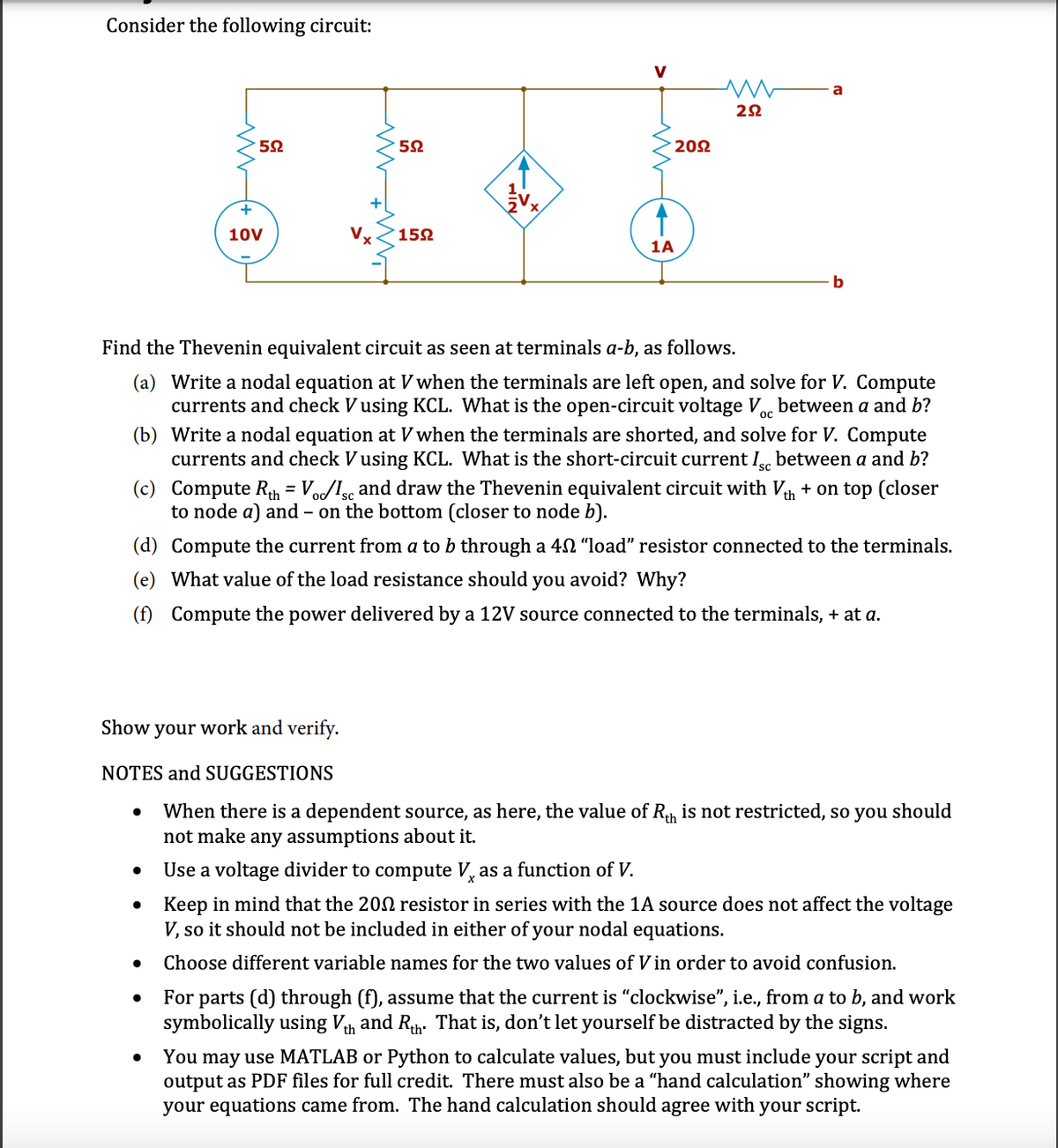Consider the following circuit: V a 202 10V 152 1A Find the Thevenin equivalent circuit as seen at terminals a-b, as follows. (a) Write a nodal equation at V when the terminals are left open, and solve for V. Compute currents and check V using KCL. What is the open-circuit voltage Vo, between a and b? (b) Write a nodal equation at V when the terminals are shorted, and solve for V. Compute currents and check V using KCL. What is the short-circuit current I between a and b? (c) Compute Rth = Vo/sc and draw the Thevenin equivalent circuit with Vh + on top (closer to node a) and – on the bottom (closer to node b). (d) Compute the current from a to b through a 40 "load" resistor connected to the terminals.
Consider the following circuit: V a 202 10V 152 1A Find the Thevenin equivalent circuit as seen at terminals a-b, as follows. (a) Write a nodal equation at V when the terminals are left open, and solve for V. Compute currents and check V using KCL. What is the open-circuit voltage Vo, between a and b? (b) Write a nodal equation at V when the terminals are shorted, and solve for V. Compute currents and check V using KCL. What is the short-circuit current I between a and b? (c) Compute Rth = Vo/sc and draw the Thevenin equivalent circuit with Vh + on top (closer to node a) and – on the bottom (closer to node b). (d) Compute the current from a to b through a 40 "load" resistor connected to the terminals.
Introductory Circuit Analysis (13th Edition)
13th Edition
ISBN:9780133923605
Author:Robert L. Boylestad
Publisher:Robert L. Boylestad
Chapter1: Introduction
Section: Chapter Questions
Problem 1P: Visit your local library (at school or home) and describe the extent to which it provides literature...
Related questions
Question
Hello, a step by step guide would be greatly appreciated. Please follow the NOTES & SUGGESTIONS at the bottom when solving, answering what is asked as I need to understand doing it and checking/verifying results, and please show every step for understanding, thanks so much :)

Transcribed Image Text:Consider the following circuit:
V
a
202
+
10V
Vx
152
1A
b
Find the Thevenin equivalent circuit as seen at terminals a-b, as follows.
(a) Write a nodal equation at V when the terminals are left open, and solve for V. Compute
currents and check Vusing KCL. What is the open-circuit voltage V between a and b?
oc
(b) Write a nodal equation at V when the terminals are shorted, and solve for V. Compute
currents and check V using KCL. What is the short-circuit current I between a and b?
(c) Compute Rh = Vo/Ige and draw the Thevenin equivalent circuit with Vh + on top (closer
to node a) and – on the bottom (closer to node b).
(d) Compute the current from a to b through a 40 "load" resistor connected to the terminals.
(e) What value of the load resistance should you avoid? Why?
(f) Compute the power delivered by a 12V source connected to the terminals, + at a.
Show your work and verify.
NOTES and SUGGESTIONS
When there is a dependent source, as here, the value of Rth is not restricted, so you should
not make any assumptions about it.
Use a voltage divider to compute V, as a function of V.
Keep in mind that the 202 resistor in series with the 1A source does not affect the voltage
V, so it should not be included in either of your nodal equations.
Choose different variable names for the two values of in order to avoid confusion.
For parts (d) through (f), assume that the current is "clockwise", i.e., from a to b, and work
symbolically using Vh and Rh. That is, don't let yourself be distracted by the signs.
You may use MATLAB or Python to calculate values, but you must include your script and
output as PDF files for full credit. There must also be a "hand calculation" showing where
your equations came from. The hand calculation should agree with your script.
Expert Solution
Step 1
“Since you have posted a question with multiple sub-parts, we will solve first three sub parts for you. To get remaining sub-part solved please repost the complete question and
mention the sub-parts to be solved.”
We have given the following problem

Trending now
This is a popular solution!
Step by step
Solved in 4 steps with 5 images

Knowledge Booster
Learn more about
Need a deep-dive on the concept behind this application? Look no further. Learn more about this topic, electrical-engineering and related others by exploring similar questions and additional content below.Recommended textbooks for you

Introductory Circuit Analysis (13th Edition)
Electrical Engineering
ISBN:
9780133923605
Author:
Robert L. Boylestad
Publisher:
PEARSON

Delmar's Standard Textbook Of Electricity
Electrical Engineering
ISBN:
9781337900348
Author:
Stephen L. Herman
Publisher:
Cengage Learning

Programmable Logic Controllers
Electrical Engineering
ISBN:
9780073373843
Author:
Frank D. Petruzella
Publisher:
McGraw-Hill Education

Introductory Circuit Analysis (13th Edition)
Electrical Engineering
ISBN:
9780133923605
Author:
Robert L. Boylestad
Publisher:
PEARSON

Delmar's Standard Textbook Of Electricity
Electrical Engineering
ISBN:
9781337900348
Author:
Stephen L. Herman
Publisher:
Cengage Learning

Programmable Logic Controllers
Electrical Engineering
ISBN:
9780073373843
Author:
Frank D. Petruzella
Publisher:
McGraw-Hill Education

Fundamentals of Electric Circuits
Electrical Engineering
ISBN:
9780078028229
Author:
Charles K Alexander, Matthew Sadiku
Publisher:
McGraw-Hill Education

Electric Circuits. (11th Edition)
Electrical Engineering
ISBN:
9780134746968
Author:
James W. Nilsson, Susan Riedel
Publisher:
PEARSON

Engineering Electromagnetics
Electrical Engineering
ISBN:
9780078028151
Author:
Hayt, William H. (william Hart), Jr, BUCK, John A.
Publisher:
Mcgraw-hill Education,